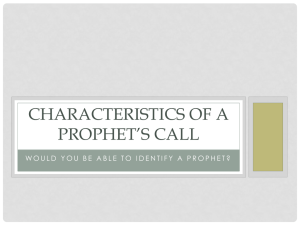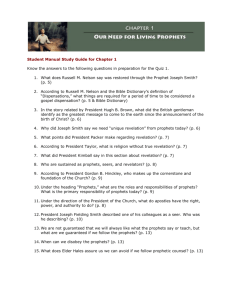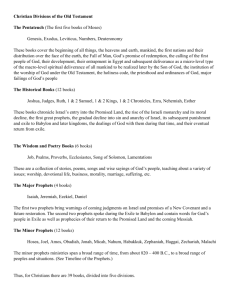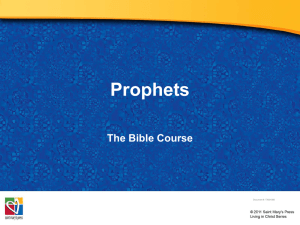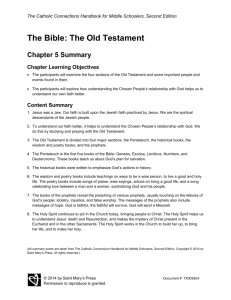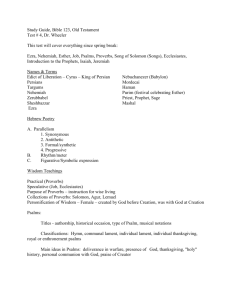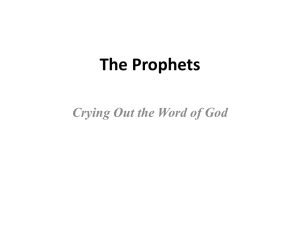7A Intro to Prophets PPT - Bartley Christian Church
advertisement
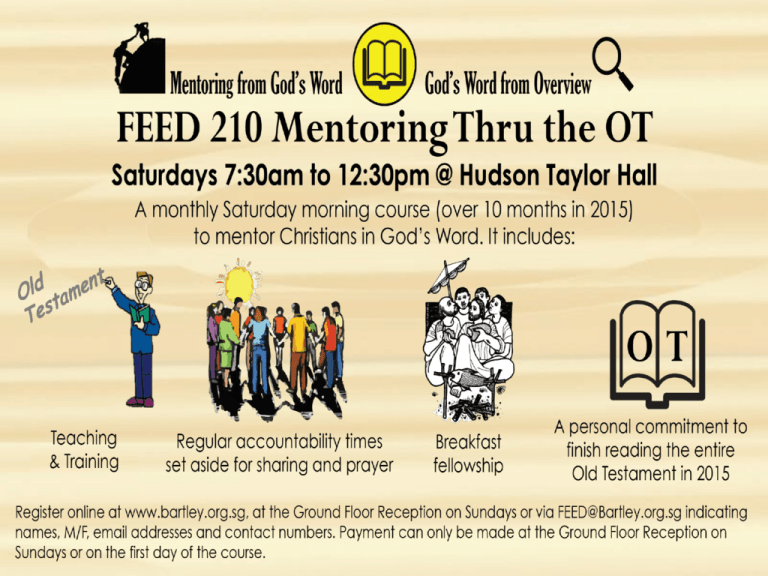
SESSION # 7
Introduction
to the
Prophets
Tablet of Zimrilim
Mari Worshipper
2.THE DEVELOPMENT OF THE PROPHETS
AND PROPHECY IN THE OLD TESTAMENT
DEMARCATION OF LEADERSHIP OFFICES
PATRIARCHAL
PERIOD
PRE-MONARCHIAL
PERIOD
MONARCHIAL
PERIOD
ABRAHAM, ISAAC,
JACOB
MOSES - JUDGES
SAMUEL
PROPHETS/PRINCE
S/
PRIESTS
PROPHETS/PRINCE
S
LEVITES
TIME
PROPHETS
KINGS
2.THE DEVELOPMENT OF THE PROPHETS
AND PROPHECY IN THE OLD TESTAMENT
PRE-MONARCHY
PROPHETS
• Charismatic leaders
• Unite Israel politically
• Reform people
spiritually
PROPHETS FROM
MONARCHY TILL
EXILE
• Did not hold leadership
positions
• Worked for monarchy
and sometimes spoke
against them
• A significant factor to the
religious history and rise
of monarchy
3. NONLITERARY & LITERARY
PROPHETS
a) Nonliterary (Preliterary)
Prophecy
• i) It is called nonliterary or preliterary
because it did not leave a literary legacy,
except as it impinged upon the history and
fortunes of the monarchy (as found in
Samuel, Kings, and Chronicles).
r
b) Literary (Classical) Prophets
i) They are literary in that they
refer to the prophets with
written records in the Bible. In
the Christian canon, they are
often referred to as the Major
and the Minor Prophets
stretching from Isaiah to
Malachi (16 prophets in 17
books).
ii) They are classical in that they
are the most familiar phase of
Israelite prophecy.
Non-literary Prophets
Literary Prophets
Also known as preliterary
prophets
Also known as classical prophets
Accounts found in the books of
Samuel, Kings, Chronicles, Ezra
and Nehemiah
Accounts found in the Major and
Minor Prophets.
Not chiefly concerned with moral
issues
Chiefly concerned with moral
issues
Spoke to individuals; a
conscience to kings
Spoke to nations
Earlier prophets
Later prophets
Did not leave behind a literary
legacy
Left behind a literary legacy
4. DESCRIPTION OF PROPHETS
IN THE OLD TESTAMENT
a) “Prophet” aybin" (nābî’) –related to
Akkadian word “to call” Therefore can
means “Called Ones”. Used more than 300
times!
“Man of God”
elōhîm)
b)
i.
~yhil{a/h' vyai (’îsh hā-
The implication of this term is that the person
was possessed by God for special service. In
the accounts of the non-literary prophets, there
is little distinction made to distinguish the
terms “man of God” and “prophet” (nābî’).
4. DESCRIPTION OF PROPHETS
IN THE OLD TESTAMENT
c)
“Seer” ha,ro (rō eh) –“to see, gaze or look”
i.
ii.
It is the same as the “Man of God” (1 Sam 9:8-9),
possible an older term.
This term is descriptive of the individual’s experience,
emphasizing the extraordinary insight that came to the
prophets.
“Visionary”
roeh.
a)
I)
II)
hz<Ax
(hōzeh) – variant form of
Like the term “seer,” “visionary” too points to the
person’s ability to receive prophecies through visions
and dreams.
They were given to dreams, vision, ecstasy, and divining,
4. DESCRIPTION OF PROPHETS
IN THE OLD TESTAMENT
e) “Sons of the prophets” ~yaiybiN>h;ynEb. ((Ben Ha-nabi’im)
I)
These were the understudies of prophets who
maintained some kind of communal existence
(e.g. 2 Kings 6:1-7).
“Diviner” or “soothsayer”
f)
I)
~s;q' (qōsēm)
This term is used of those who practiced
formal divination, perhaps using lots or other
methods of discerning the will of deity, but it is
not applied to those prophets who receive
legitimate sanction in the OT.
5. THE HISTORICAL CONTEXT
OF THE LITERAL PROPHETS
The word Assyria is derived from
mât Aššur, which means "the
country of the god Aššur". The
capital of Assyria, which was more
or less situated between the rivers
Tigris and Little Zab, was also called
after this god.
Shalmaneser III (859-824 BC)
Ben-Hadad II of
Damascus and
Ahab of Israel
blocked
Shalmaneser III’s
advance in 853 B.C.
King Jehu paying homage to Shalmaneser III
Tiglath-Pileser III receiving
homage
The walls of Nineveh
The Fall of Nineveh
Chronicle
Climax: Fall
of Samaria
(722 BCE)
Stele of Hammurabi
Nebuchadnezzar II
(605-562 BC)
Climax: Fall of Jerusalem 586 BCE
Climax: Return from Exile (538 BC)
6. PRINCIPLES IN READING
THE PROPHETS
a. Read in tandem with the historical context.
b. Read them as individual oracles.
c. Look out for the following literary styles:
a. Poetry
b. Predictions and Fulfillments
c. Apocalypse
d. They always go back to the covenant.
e. The NT inspirational interpretations of OT
that readers cannot repeat
10. COMMON THEMES OF
PROPHETIC WRITINGS
a) Covenant obligations
b) The Day of the Lord
c) The Concept of the
Messiah
